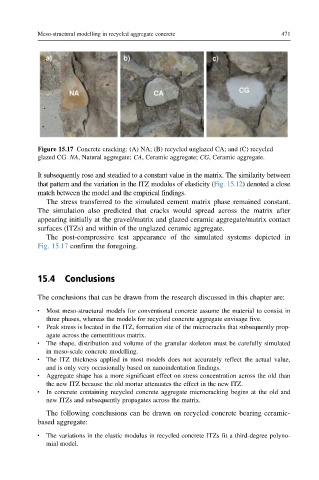Page 523 - New Trends in Eco efficient and Recycled Concrete
P. 523
Meso-structural modelling in recycled aggregate concrete 471
Figure 15.17 Concrete cracking: (A) NA; (B) recycled unglazed CA; and (C) recycled
glazed CG. NA, Natural aggregate; CA, Ceramic aggregate; CG, Ceramic aggregate.
It subsequently rose and steadied to a constant value in the matrix. The similarity between
that pattern and the variation in the ITZ modulus of elasticity (Fig. 15.12) denoted a close
match between the model and the empirical findings.
The stress transferred to the simulated cement matrix phase remained constant.
The simulation also predicted that cracks would spread across the matrix after
appearing initially at the gravel/matrix and glazed ceramic aggregate/matrix contact
surfaces (ITZs) and within of the unglazed ceramic aggregate.
The post-compressive test appearance of the simulated systems depicted in
Fig. 15.17 confirm the foregoing.
15.4 Conclusions
The conclusions that can be drawn from the research discussed in this chapter are:
Most meso-structural models for conventional concrete assume the material to consist in
three phases, whereas the models for recycled concrete aggregate envisage five.
Peak stress is located in the ITZ, formation site of the microcracks that subsequently prop-
agate across the cementitious matrix.
The shape, distribution and volume of the granular skeleton must be carefully simulated
in meso-scale concrete modelling.
The ITZ thickness applied in most models does not accurately reflect the actual value,
and is only very occasionally based on nanoindentation findings.
Aggregate shape has a more significant effect on stress concentration across the old than
the new ITZ because the old mortar attenuates the effect in the new ITZ.
In concrete containing recycled concrete aggregate microcracking begins at the old and
new ITZs and subsequently propagates across the matrix.
The following conclusions can be drawn on recycled concrete bearing ceramic-
based aggregate:
The variations in the elastic modulus in recycled concrete ITZs fit a third-degree polyno-
mial model.

